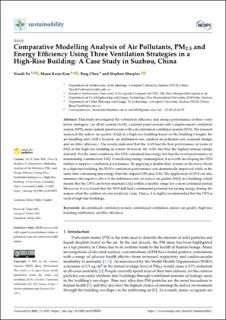| dc.contributor.author | Fu, Nuodi | |
| dc.contributor.author | Kim, Moon Keun | |
| dc.contributor.author | Chen, Bing | |
| dc.contributor.author | Sharples, Stephen | |
| dc.date.accessioned | 2022-05-25T07:07:43Z | |
| dc.date.available | 2022-05-25T07:07:43Z | |
| dc.date.created | 2021-09-13T09:39:38Z | |
| dc.date.issued | 2021-07-28 | |
| dc.identifier.issn | 2071-1050 | |
| dc.identifier.uri | https://hdl.handle.net/11250/2996074 | |
| dc.description.abstract | This study investigated the ventilation efficiency and energy performance of three ventilation strategies—an all-air system (AAS), a radiant panel system with a displacement ventilation system (DPS), and a radiant panel system with a decentralized ventilation system (DVS). The research analyzed the indoor air quality (IAQ) in a high-rise building based on the building’s height, the air handling unit (AHU) location, air infiltration rate, outdoor air pollution rate, seasonal change, and air filter efficiency. The results indicated that the AAS had the best performance in terms of IAQ in the high-rise building in winter; however, the AAS also had the highest annual energy demand. For the same conditions, the DVS consumed less energy but had the worst performance in maintaining a satisfactory IAQ. Considering energy consumption, it is worth developing the DVS further to improve ventilation performance. By applying a double-filter system on the lower floors in a high-rise building, the DVS’s ventilation performance was dramatically improved while at the same time consuming less energy than the original DPS and AAS. The application of DVS can also minimize the negative effect of the infiltration rate on indoor air quality (IAQ) in a building, which means that the DVS can better maintain IAQ within a healthy range for a more extended period. Moreover, it was found that the DVS still had a substantial potential for saving energy during the season when the outdoor air was relatively clean. Hence, it is highly recommended that the DVS is used in high-rise buildings. | en_US |
| dc.language.iso | eng | en_US |
| dc.publisher | MDPI | en_US |
| dc.relation.ispartofseries | Sustainability;Volume 13 / Issue 15 | |
| dc.rights | Navngivelse 4.0 Internasjonal | * |
| dc.rights.uri | http://creativecommons.org/licenses/by/4.0/deed.no | * |
| dc.subject | Decentralized ventilation systems | en_US |
| dc.subject | Centralized ventilation | en_US |
| dc.subject | Indoor air quality | en_US |
| dc.subject | High-rise buildings | en_US |
| dc.subject | Infiltration | en_US |
| dc.subject | Air filter efficiency | en_US |
| dc.title | Comparative Modelling Analysis of Air Pollutants, PM2.5 and Energy Efficiency Using Three Ventilation Strategies in a High-Rise Building: A Case Study in Suzhou, China | en_US |
| dc.type | Peer reviewed | en_US |
| dc.type | Journal article | en_US |
| dc.description.version | publishedVersion | en_US |
| dc.rights.holder | © 2021 by the authors | en_US |
| dc.source.articlenumber | 8453 | en_US |
| cristin.ispublished | true | |
| cristin.fulltext | original | |
| cristin.qualitycode | 1 | |
| dc.identifier.doi | https://doi.org/10.3390/su13158453 | |
| dc.identifier.cristin | 1933608 | |
| dc.source.journal | Sustainability | en_US |
| dc.source.volume | 13 | en_US |
| dc.source.issue | 15 | en_US |
| dc.source.pagenumber | 1-20 | en_US |

